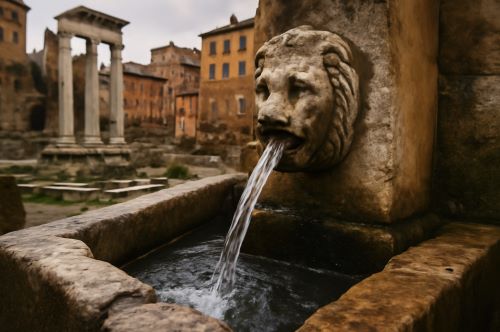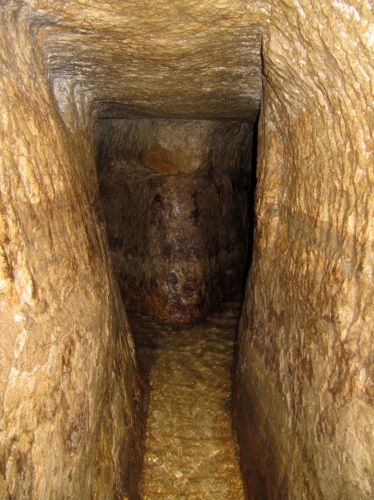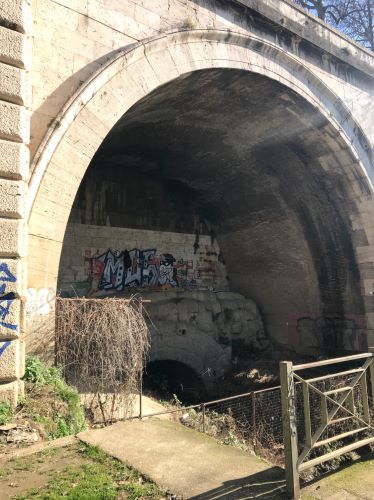

In antiquity, control of water was synonymous with control of life.

By Matthew A. McIntosh
Public Historian
Brewminate
Introduction: The Fragility of Ancient Urban Water Systems
In the ancient world, a city’s prosperity—and survival—often depended on its water supply. Civilizations rose alongside rivers, built vast aqueducts, and engineered intricate systems of cisterns and reservoirs to support growing urban populations. Yet these same systems were also highly vulnerable—to war, climate fluctuation, disease, and sabotage. A disruption to a city’s water supply could prove catastrophic, not merely for hygiene or agriculture, but for its very political and military resilience. This essay examines several notable episodes in antiquity when urban water systems faced existential threats, revealing the centrality of water infrastructure in shaping the fate of cities from Mesopotamia to the Mediterranean.
Jerusalem: Water under Siege

One of the most prominent examples of water vulnerability in antiquity comes from Jerusalem, a city whose geography posed constant hydraulic challenges. Perched on a limestone ridge without a major river, Jerusalem relied heavily on the Gihon Spring, accessible only from the Kidron Valley. To protect and extend access, ancient engineers constructed tunnels and channels—most notably Hezekiah’s Tunnel, a 533-meter passage built in the late 8th century BCE to channel water into the city in anticipation of Assyrian attack.1
Despite such efforts, the city’s water systems were regularly compromised during military sieges. During the Babylonian siege of 587 BCE, much of Jerusalem’s population was cut off from external springs and forced to rely on cisterns, which quickly ran dry or were contaminated. The situation was worse during the Roman siege of 70 CE, when Titus’s forces besieged the city for months. According to Josephus, conditions deteriorated so drastically that people consumed sewage and blood, and dehydration contributed to the city’s surrender.2 Jerusalem’s example underscores how even a spiritually central and technologically prepared city could succumb to water insecurity under siege.
Athens and the Plague: Sanitation Collapse
In the early years of the Peloponnesian War, Athens found itself overburdened by its own defensive strategy. Pericles ordered the rural population to retreat behind the Long Walls, swelling the city’s population far beyond its sustainable limits. Although Athens had cisterns and wells, the sheer density of inhabitants led to unsanitary conditions and contaminated water sources.
In 430 BCE, a plague struck the city, killing up to a quarter of its population. While the exact pathogen remains debated, Thucydides, a witness to the events, noted the squalid living conditions and lack of clean water as factors that exacerbated the epidemic.3 This was not an instance of direct sabotage, but a collapse from within—proof that even democratic, highly developed poleis could falter if their water systems were overwhelmed by population pressure.
Rome and the Sabotage of the Aqueducts

Ancient Rome was justly famous for its aqueducts, which carried water over vast distances to supply baths, fountains, homes, and latrines. At the height of the empire, the city received over 300 million gallons of water per day from eleven aqueducts.4 Yet this very reliance on complex infrastructure created vulnerabilities.
During the Gothic siege of Rome in 537 CE, the Ostrogoths deliberately cut the aqueducts. This action not only deprived Romans of drinking water but also crippled the Cloaca Maxima, Rome’s extensive sewer system, which depended on aqueduct flow to flush waste. The resulting breakdown in sanitation contributed to disease and demoralization. Procopius, who chronicled the siege, noted that water had to be drawn by hand from the Tiber—brackish, polluted, and far from ideal.5 The siege revealed how Rome’s engineering marvels had become a single point of failure under assault.
Carthage: Aqueducts as a Tactical Target
In the Third Punic War (149–146 BCE), the Romans laid siege to Carthage, the wealthy Phoenician city-state and long-time rival. Scipio Aemilianus, recognizing the strategic value of Carthage’s water infrastructure, targeted its aqueducts and cisterns, which were essential during the dry season. While the city had reservoirs and wells, Roman disruption efforts created water scarcity that compounded the starvation and exhaustion of Carthaginian defenders.
Although Appian’s account emphasizes the military dimensions of the siege, archaeological evidence supports the idea that hydraulic sabotage played a role in hastening Carthage’s fall.6 The tactic was simple and effective: cut the city’s arteries, and its resistance would weaken from within.
Babylon and the Euphrates Diversion
The conquest of Babylon by Cyrus the Great in 539 BCE remains one of the most storied in ancient history. Herodotus recounts that Cyrus diverted the Euphrates River, lowering the water level enough for his troops to march under the city’s river gates and capture it by surprise.7 Whether literally true or embellished, the story highlights Babylon’s dependence on controlled river flow. The Euphrates was not merely a source of water but a structural element in the city’s defenses and economy.
While Babylon boasted canals, levees, and reservoirs, any disruption in Euphrates flow—whether by human design or natural flood—was catastrophic. The strategy attributed to Cyrus illustrates how control over water could undermine even the mightiest walls.
Conclusion: Water as a Weapon and a Weakness
The ancient world’s dependence on local or engineered water sources created both great ingenuity and great fragility. Cities that mastered hydraulic management flourished, but in times of crisis—whether siege, epidemic, or sabotage—their water systems became points of vulnerability. The targeting or collapse of water infrastructure was not merely collateral damage; it was often central to the strategy of war or the spread of disease.
These episodes remind us that in antiquity, control of water was synonymous with control of life, and its loss could bring even the most powerful urban centers to their knees.
Appendix
Endnotes
- Dan Gill, “Hezekiah’s Tunnel Reexamined,” Biblical Archaeology Review 20, no. 4 (1994): 45–49.
- Flavius Josephus, The Jewish War, trans. G.A. Williamson (London: Penguin Classics, 1981), 5.12.4–5.
- Thucydides, The Peloponnesian War, trans. Richard Crawley (New York: Modern Library, 1982), 2.47–2.54.
- A.M. Wilson, The Infrastructure of the Roman City (Cambridge: Cambridge University Press, 2003), 129.
- Procopius, Wars of Justinian, trans. H.B. Dewing (Cambridge: Harvard University Press, 1914), 5.22.
- Appian, The Punic Wars, trans. Horace White (London: Macmillan, 1899), 128–135.
- Herodotus, Histories, trans. Aubrey de Sélincourt (London: Penguin Classics, 2003), 1.191.
Bibliography
- Appian. The Punic Wars. Translated by Horace White. London: Macmillan, 1899.
- Gill, Dan. “Hezekiah’s Tunnel Reexamined.” Biblical Archaeology Review 20, no. 4 (1994): 45–49.
- Herodotus. Histories. Translated by Aubrey de Sélincourt. London: Penguin Classics, 2003.
- Josephus, Flavius. The Jewish War. Translated by G.A. Williamson. London: Penguin Classics, 1981.
- Procopius. Wars of Justinian. Translated by H.B. Dewing. Cambridge: Harvard University Press, 1914.
- Thucydides. The Peloponnesian War. Translated by Richard Crawley. New York: Modern Library, 1982.
- Wilson, A.M. The Infrastructure of the Roman City. Cambridge: Cambridge University Press, 2003.
Originally published by Brewminate, 07.04.2025, under the terms of a Creative Commons Attribution-NonCommercial-NoDerivatives 4.0 International license.


